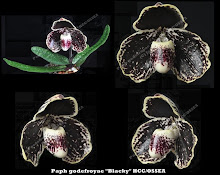
Thursday, January 29, 2009
Parvi x Brachy (hangianum x XGreyi)

Another posting of a cross between a brachy(XGreyi) and parvi (hangianum).
Supposedly from the same flask but the bottom clone has no spotting on the petals and sepal.
The yellow colour of hangianum dominates the flower over X Greyi (niveum x godefroyae).
Hangianum produces fragrance when in bloom. Somehow this is absent for this cross.
Paph leucochilum and godefroyae
Wednesday, January 28, 2009
Deflasked and flowered.
My own crossing of leucochilum
 This is a cross from my leucochilums done by a local Lab. Here is an estimate as to how long you would take to arrive at this stage.
This is a cross from my leucochilums done by a local Lab. Here is an estimate as to how long you would take to arrive at this stage.Crossed/pollinated in April 2007.
Harvested and sent to Lab Dec 2007.
Flask ready in Sept 2008.
All in all it takes about 18 months. After deflasking, it would take between 2 to 3 years for them to flower.
Sure it needs some patience for those who wish to grow from flask.
Paph angthong alba
What do you think it is?

Could this be a bellatullum cross with niveum? A flask that was given by a thai friend without knowing what went into the cross.
Very nice and round form and fine spottings like bellatullum and the white background of niveum.
A very showy plant even without the flower as the leaves are fat and stout with very light green serrated markings.
Paph thaianum

What do you think? A form of niveum or a species by itself? A plant that was discovered in recent years.
I reckon is a species and not a form, if you compare the flower as well as the leaf size.
The plant is much smaller than a niveum. I have several flowering plants and the leaves are about 2 cm across and 5 to 8 cm long.
A species that is beginning to appear in flask list. Hope to get a good clone flask. A plant that you can grow and do not take up too much space.
Brachy x Parvi
OSSEA Jan 2009 Table Display - Twin flower
Paph concolor - very dark form
Paph concolor var longipetulum
Paph niveum - 18 months out from flask
OSSEA Jan 2009 Table Display
Some leucochilums from 2008
Subscribe to:
Comments (Atom)










